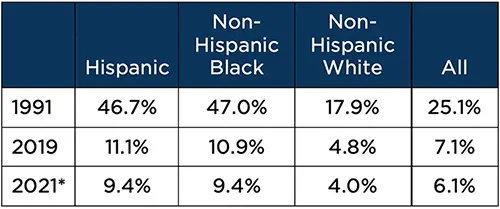
Trends in teen childbearing in the United States have been positive. According to Child Trends’ original analysis, in 1991, just over one quarter of 15-year-old females in the United States were estimated to have a birth by age 20, based on age-specific birth rates in that year.[1] In 2021, the comparable figure was just 6 percent, a decline of almost 76 percent in just 30 years.
Percentage of 15-year-old Females Estimated to Have a Birth Before Age 20, by Year and Race/Ethnicity

Sources: Data on births come from the NCHS Vital Statistics System Birth Data files. 1991-2019 data on population counts come from the NCHS Population Estimates and 2021 population counts come from CDC WONDER, which both come from the U.S. Census Bureau population estimates. For 1991 and 2019, birth and population counts by race and ethnicity use bridged-race categories. In 2021, only the single-race categorization is available (this categorization includes a multiple race option that is not included in the bridged-race categories).
* Readers should be cautious in comparing race-specific 2021 findings to previous years.
Similarly large percent declines in teen births have occurred across all race and ethnic groups for which data are available, including youth who identify as Hispanic, non-Hispanic Black, and non-Hispanic White. Nonetheless, racial and ethnic disparities in teen childbearing persist, which research has tied to a long history of racism and systemic inequities. These experiences limit access to and trust in reproductive health care, create stress, and limit opportunities for economic stability and mobility across the life course for populations who do not identify as White.
The increased use of contraceptives—especially highly effective methods such as the IUD (intrauterine device) and implant—and declines in sexual activity among youth are the immediate factors driving overall declines in teen birth rates, although the relative role of each depends on the time period examined. However, uncertainty remains about which more distant factors might be driving the decline in sex and increase in contraceptive use. Research indicates—see, for example, these reviews of relevant literature—that many factors likely play a role, including changes in social norms, technologies that impact social relationships and access to information, the labor market, and the economy more generally.
Methodology and Data Sources
To calculate the percentage of females who had a first birth in each age group (a single year of age for ages 15-19), we divided the number of women with a first birth in that age group by the population of females in that age group. In making these calculations, we adjusted for the percentage of the population that had already had a first birth. For instance, the population of 16-year-olds at risk of giving birth to a first child in a given year was reduced by the estimated percentage of teens who had already given birth at age 15. We then added the percentages for ages 15-19 to create the estimated percentage of 15-year-old females projected to have a baby before age 20.
Data for the numerator (number of first births) were drawn from NCHS Vital Statistics System Birth Data files (collected from birth certificates). 1991-2019 data on population counts come from the NCHS Population Estimates and 2021 population counts come from CDC WONDER, which both come from the U.S. Census Bureau population estimates.
Footnote
[1] This estimate does not use data from the same women over time to calculate the likelihood of actually having a birth by age 20. Rather, for each year, we estimate the proportion of 15-year old females we project will become teen mothers by age 20, based on the age-specific birth rates for teens ages 15, 16, 17, 18, and 19 in each particular year.
Related Research
- The 30-Year Decline in Teen Birth Rates Has Accelerated Since 2010
- Lessons From a Historic Decline in Child Poverty
- State-level Data for Understanding Child Poverty
- Preventing Births to Teens Is Associated With Long-term Health and Socioeconomic Benefits, According to Simulation
- State-level Abortion Restrictions Will Negatively Impact Teens and Children
- El Camino: Helping Teens Set Life Goals and Promote Sexual Health
- School-based Strategies to Support Adolescent Sexual and Reproductive Health
Suggested Citation
Wildsmith, E., Welti, K., Finocharo, J., Ryberg, R., & Manlove, J. (2022, December 23). Teen births have declined by more than three quarters since 1991. Child Trends. https://www.childtrends.org/blog/teen-births-have-declined-by-more-than-three-quarters-since-1991
© Copyright 2025 ChildTrendsPrivacy Statement
Newsletter SignupLinkedInYouTubeBlueskyInstagram



